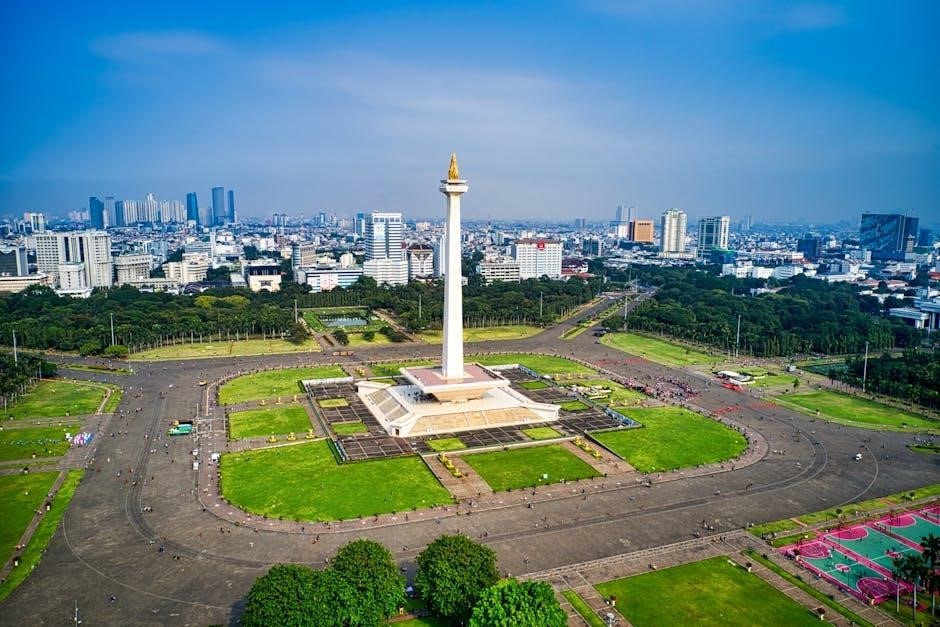The Jakarta Method, a book by Vincent Bevins, explores the 1965-66 Indonesian massacres and their global implications, revealing U.S. involvement in Cold War anticommunist campaigns. It connects Indonesia’s mass killings to similar events in Latin America, offering a chilling perspective on geopolitical strategies that shaped modern authoritarianism and international relations. The book has sparked critical discussions on foreign policy, propaganda, and human rights, becoming a significant resource for understanding Cold War dynamics and their lasting impact. Bevins’ work is both a historical account and a warning, urging reflection on the ethical consequences of political violence.
Overview of the Jakarta Method
The Jakarta Method, detailed in Vincent Bevins’ book, examines the U.S.-backed anticommunist campaigns that led to mass killings in Indonesia during 1965-66. This violent strategy was replicated in over 20 countries, shaping Cold War geopolitics. Bevins reveals how Indonesia’s transition to authoritarian rule and Latin America’s political shifts were influenced by these events. The book highlights the role of propaganda and media in justifying such actions, offering a chilling perspective on how global security strategies were formulated. By connecting these historical events to modern-day issues, Bevins provides a critical analysis of the long-term consequences of political violence and its impact on global stability.
Historical Context and Significance
The Jakarta Method rooted in the 1965-66 Indonesian massacres, marks a pivotal moment in Cold War history. It highlights the U.S.-backed extermination of communists, which spread to over 20 countries, reshaping global politics. This strategy, justified through propaganda, led to authoritarian rule in Indonesia and influenced Latin America’s political landscape. The mass killings, supported by Western powers, demonstrate the extreme measures taken to combat communism. Bevins’ work underscores the transition from democracy to dictatorship in Indonesia and the broader implications of such campaigns. This dark chapter in history reveals the ethical dilemmas of political violence and its enduring impact on global stability and human rights.
Purpose of the Article
This article aims to shed light on the lesser-known Cold War atrocities, particularly the 1965-66 Indonesian massacres, and their global repercussions. By examining the Jakarta Method, it seeks to uncover how U.S.-backed anticommunist campaigns led to mass killings and authoritarian rule. The purpose is to provide a comprehensive understanding of these events, linking them to broader geopolitical strategies. It also endeavors to highlight the ethical questions surrounding such interventions and their long-term effects on international relations; Through this analysis, the article hopes to inform readers about a dark chapter in history and its relevance to contemporary political thought and activism.
Historical Background
The Jakarta Method traces the 1965-66 Indonesian massacres, a pivotal Cold War event where anticommunist campaigns led to mass killings, shaped by U.S. geopolitical strategies and authoritarian transitions.
The 1965-66 Massacres in Indonesia
The 1965-66 massacres in Indonesia were a series of mass killings targeting communists, leftists, and alleged sympathizers of the Indonesian Communist Party (PKI). Estimates suggest between 500,000 to 1 million people were killed, marking one of the deadliest campaigns of the Cold War. The violence was orchestrated by the Indonesian military, backed by the U.S. and other Western powers, as part of a broader anticommunist crackdown. This period led to the rise of authoritarian rule under General Suharto, who ruled Indonesia for decades. The massacres remain a dark chapter in Indonesian history, with victims’ families still seeking justice and accountability today.
US Involvement in Cold War Politics
The United States played a pivotal role in Cold War politics, particularly in its support for anticommunist campaigns globally. In Indonesia, the U.S. provided logistical and ideological backing to the military regime, facilitating the mass killings of communists and alleged sympathizers. This involvement was part of a broader strategy to suppress leftist movements worldwide, aligning with the U.S. goal of containing Soviet influence. Declassified documents reveal that the U.S. supplied weapons, intelligence, and financial aid to the Indonesian military, enabling the brutal crackdown. This intervention not only shaped Indonesia’s political trajectory but also set a precedent for U.S.-backed anticommunist violence in other regions, such as Latin America.

Latin America and the Spread of Anticommunist Campaigns
The Jakarta Method details how U.S.-backed anticommunist campaigns spread across Latin America, mirroring Indonesia’s mass killings. Countries like Brazil, Argentina, and Chile experienced similar trajectories, with military coups and brutal suppression of leftist movements. The U.S. supported these regimes ideologically and militarily, fostering an environment of fear and repression. This Cold War strategy aimed to prevent socialist revolutions, often at the cost of democracy and human rights. The book reveals how the Indonesian model inspired Latin American dictatorships, leading to decades of authoritarian rule and social upheaval. These events highlight the transnational impact of U.S. foreign policy and its enduring legacy in the region.
Global Cold War Dynamics
The Jakarta Method reveals how the Cold War’s ideological battles shaped global politics, with the U.S. and its allies exporting anticommunist strategies worldwide. Indonesia’s 1965-66 massacres were part of a broader pattern of U.S.-backed interventions aimed at preventing socialist revolutions. These actions often involved covert operations, propaganda, and military support for authoritarian regimes. The book highlights how such interventions created a ripple effect, inspiring similar campaigns in Latin America, Africa, and Asia. This global dynamic underscores the interconnected nature of Cold War conflicts, where local struggles were framed as part of a larger ideological war. Bevins’ work illustrates how these dynamics continue to influence contemporary geopolitics and international relations, offering a critical lens on the legacy of Cold War policies. The Jakarta Method serves as a reminder of the far-reaching consequences of ideological warfare and its impact on human rights and democracy worldwide.

Author and Book Details
Vincent Bevins, a U.S.-born journalist, authored The Jakarta Method, exploring Cold War atrocities and U.S. involvement in Indonesia and Latin America. His work exposes mass killings and political shifts, offering a critical perspective on geopolitics and human rights.
Vincent Bevins: Biography and Contributions
Vincent Bevins is an American journalist with a distinguished career, having worked for major outlets like the Financial Times and Los Angeles Times. His reporting spans multiple continents, including stints in London and Brazil, where he gained deep insights into global politics and social movements. Bevins’ contributions to journalism are marked by his ability to uncover hidden histories and connect them to broader geopolitical trends. His book, The Jakarta Method, is a seminal work that has reshaped understanding of Cold War-era atrocities and U.S. foreign policy. Through meticulous research and compelling storytelling, Bevins sheds light on the often-overlooked victims of political violence and the enduring impact of these events on modern society.
The Jakarta Method: Book Overview
The Jakarta Method is a 2020 book by Vincent Bevins that examines the 1965-66 Indonesian massacres and their global implications. It reveals how the U.S. supported anti-communist campaigns worldwide, linking Indonesia’s mass killings to similar events in Latin America. The book exposes the dark side of Cold War geopolitics, offering a detailed account of how authoritarian regimes were installed with Western backing. Bevins’ work is a critical exploration of political violence, propaganda, and their enduring legacies. It has become a key resource for understanding the intersections of foreign policy, ideology, and human rights, making it essential reading for those seeking to grasp the complexities of modern global politics.
Publication and Reception
The Jakarta Method was published in 2020 to significant acclaim, drawing attention for its meticulous documentation of Cold War atrocities. The book has been praised for its clarity and depth, making complex historical events accessible to a broad audience. It has become a vital resource for scholars, activists, and policymakers seeking to understand the legacy of U.S. foreign policy. The book’s reception has been particularly strong among those interested in global justice and human rights, sparking debates about the ethical implications of political violence. Its impact extends beyond academia, resonating with readers in Indonesia, Latin America, and beyond, where the events described remain deeply relevant today.

Key Arguments and Themes
The Jakarta Method reveals the U.S.-backed mass killings in Indonesia and their global implications, exposing Cold War strategies that fueled authoritarianism and anticommunist violence worldwide.
Mass Murder Programs and Their Impact
The Jakarta Method details the systematic mass murder of communists and alleged leftist sympathizers in Indonesia during 1965-66, sponsored by the U.S. and its allies. Over 500,000 people were killed in one of the most violent anticommunist campaigns of the Cold War. These programs were replicated in Latin America, creating a model of state-sponsored terror. The book reveals how such violence reshaped political landscapes, entrenched authoritarian regimes, and silenced dissent globally. Bevins’ research exposes the chilling efficiency of these campaigns and their lasting impact on global security strategies, human rights, and the legacy of U.S. foreign policy during the Cold War era.
US Foreign Policy During the Cold War
The Jakarta Method reveals the darker side of U.S. foreign policy during the Cold War, highlighting its role in supporting mass murder programs globally. The U.S. backed anticommunist campaigns in Indonesia and Latin America, justifying interventions as necessary to contain communism. These actions often involved covert operations, propaganda, and military aid to authoritarian regimes. Bevins’ research shows how U.S. policies prioritized geopolitical stability over human rights, leading to devastating consequences. The book critiques the moral ambiguity of U.S. actions, exposing how Cold War strategies perpetuated violence and undermined democratic values worldwide. It challenges the narrative of the U.S. as a global moral leader, offering a stark reminder of the ethical costs of its foreign policy decisions.
The Role of Propaganda and Media
The Jakarta Method underscores the critical role of propaganda and media in shaping public perception during the Cold War. The U.S. and its allies utilized media campaigns to demonize communism, creating a narrative that justified mass killings and authoritarian rule. Propaganda was instrumental in legitimizing violent anticommunist campaigns, often distorting reality to garner domestic and international support. Bevins highlights how media manipulation obscured the true horrors of Indonesia’s 1965-66 massacres, framing them as necessary measures against communism. This propaganda machinery not only facilitated political violence but also entrenched fear and misinformation, enabling regimes to consolidate power while maintaining a veneer of moral authority. The book reveals how media became a tool for ideological control, perpetuating repression and silencing dissent.
Global Implications
The Jakarta Method reveals how Cold War-era violence and propaganda shaped global politics, influencing authoritarian regimes and security strategies worldwide, with lasting impacts on modern international relations.
Indonesia’s Transition to Authoritarian Rule
The 1965-66 massacres in Indonesia, supported by the U.S., marked a brutal shift to authoritarian rule under General Suharto. The Jakarta Method details how this violence, targeting communists and alleged leftists, entrenched military dominance, silencing political dissent and establishing the New Order regime. This period saw widespread human rights abuses, censorship, and the suppression of democratic institutions. The transition solidified Indonesia’s authoritarian governance, lasting decades and leaving a legacy of fear and repression. Bevins’ work highlights how this era reshaped Indonesian society, perpetuating a culture of impunity and undermining democratic aspirations, with far-reaching consequences for the nation’s political landscape.

Latin America’s Political Shifts
The Jakarta Method reveals how U.S.-backed anticommunist campaigns in Indonesia inspired similar strategies in Latin America, leading to authoritarian regimes and political upheaval. Countries like Brazil, Chile, and Argentina experienced military coups and repression, mirroring Indonesia’s 1965-66 massacres. These events marked a shift away from democratic governance, as leftist movements were brutally suppressed. The book highlights how the Jakarta Method became a blueprint for quashing dissent globally, fostering an environment of fear and political instability. Latin America’s transition to authoritarian rule during the Cold War era was deeply intertwined with U.S. foreign policy, leaving lasting scars on the region’s political landscape and human rights record. This dark legacy continues to resonate today.
Global Security Strategies Post-Cold War
The Jakarta Method examines how Cold War-era tactics influenced post-Cold War security strategies, revealing a troubling legacy of state-sponsored violence and authoritarianism. The book highlights how the U.S. and its allies replicated Indonesia’s mass murder programs in other regions, establishing a template for suppressing dissent. Post-Cold War, these strategies evolved into more covert operations, maintaining power through propaganda and selective interventions. Bevins argues that understanding this history is crucial for addressing current global issues, where similar patterns of state violence and media manipulation persist. The Jakarta Method serves as a warning, urging policymakers to rethink security approaches that prioritize stability over human rights and democracy. Its insights are vital for crafting ethical foreign policies in today’s complex geopolitical landscape.
Evidence and Documentation
The Jakarta Method relies on declassified files, eyewitness accounts, and historical records to document the U.S.-backed mass killings in Indonesia and beyond, providing chilling evidence of Cold War atrocities.
Primary Sources and Eyewitness Accounts
Primary sources and eyewitness accounts are central to documenting the 1965-66 Indonesian massacres, offering vivid testimonies of survivors and perpetrators. These accounts reveal the scale of violence and its orchestration, supported by archival records and personal narratives. Survivors’ stories detail mass killings, detention camps, and forced disappearances, while archival documents expose the role of state and external actors. Eyewitness testimonies also highlight the broader Cold War context, linking Indonesia’s events to similar anticommunist campaigns in Latin America. These sources provide irrefutable evidence of the atrocities, challenging official narratives and shedding light on the human cost of geopolitical strategies. Activists and scholars have tirelessly preserved these records, ensuring their accessibility for historical scrutiny.
Declassified Documents and Historical Records
Declassified documents and historical records provide critical evidence of the 1965-66 Indonesian massacres and their global implications. These records reveal the direct involvement of foreign governments, including the U.S., in supporting the Indonesian military coup and subsequent mass killings. Documents show that Western powers were not only aware of the atrocities but also actively supported the anticommunist purge. Archival materials detail how these events were part of a broader Cold War strategy to suppress left-wing movements worldwide. Such records have been instrumental in reconstructing the timeline of events and understanding the geopolitical motivations behind the violence. They remain vital for scholars and activists seeking to uncover the truth about this dark chapter in history.

Critique and Controversies
The Jakarta Method has sparked debates on U.S. interventionism and ethical questions surrounding mass killings, challenging narratives of Cold War geopolitics and highlighting moral ambiguities in foreign policy decisions.
Debates on US Interventionism
The Jakarta Method has ignited significant debates about US interventionism during the Cold War, particularly its role in supporting anticommunist campaigns globally. Critics argue that the US-backed mass killings in Indonesia and Latin America reveal a morally fraught foreign policy, prioritizing ideological victories over human rights. Bevins’ work challenges the narrative of US exceptionalism, highlighting how covert operations and propaganda were used to destabilize governments perceived as leftist. This has sparked discussions on the ethical implications of such interventions and their long-term impact on democracy and stability in affected regions. The book serves as a critical lens for understanding the consequences of US geopolitical strategies and their ongoing influence on contemporary foreign policy debates.

Ethical Questions Surrounding Mass Killings
The Jakarta Method raises profound ethical questions about the mass killings in Indonesia and their global implications, challenging the moral justification for such violence. Bevins’ documentation of the 1965-66 massacres highlights the systematic targeting of communists, intellectuals, and ethnic minorities, revealing a brutal campaign supported by Western powers. This forces a reckoning with the complicity of nations in human rights atrocities committed under the guise of Cold War ideology. The book prompts readers to consider the long-term consequences of such actions on victims’ families and societies, urging accountability and reflection on the ethical responsibilities of global powers in preventing future atrocities.

Legacy and Impact
The Jakarta Method has left a lasting impact, exposing the hidden history of U.S.-backed mass killings and inspiring global activism against authoritarianism and political violence.
Modern-Day Relevance of the Book
Vincent Bevins’ The Jakarta Method remains strikingly relevant today, offering critical insights into the long-term effects of Cold War policies on global politics and human rights. The book sheds light on how U.S.-backed anticommunist campaigns shaped authoritarian regimes, not only in Indonesia but also across Latin America. Its exploration of propaganda, political violence, and foreign intervention resonates deeply in an era marked by ongoing debates about democracy, imperialism, and social justice. By uncovering suppressed histories, Bevins’ work serves as a vital resource for understanding the roots of modern geopolitical tensions and the enduring impact of historical injustices on contemporary society.
Influence on Political Thought and Activism
The Jakarta Method has profoundly influenced political thought and activism, particularly among left-wing movements worldwide. By exposing the U.S.-backed mass killings in Indonesia and similar campaigns in Latin America, the book challenges narratives about democracy and human rights. Activists increasingly cite Bevins’ work to understand the legacy of Cold War interventions and their modern implications. The book has inspired discussions on imperialism, propaganda, and state violence, urging activists to critically examine historical and contemporary foreign policies. Its revelations have also fueled movements demanding accountability for past atrocities and advocating for a more just global order. Bevins’ work continues to empower activists seeking to address systemic inequality and political repression.

Modern Relevance
The Jakarta Method remains highly relevant today, offering insights into Cold War geopolitics and their modern echoes. It highlights the enduring impact of U.S. foreign policy on global stability and human rights, resonating with contemporary debates on imperialism, propaganda, and state violence. The book serves as a cautionary tale, urging policymakers and activists to learn from history and address ongoing inequalities and injustices worldwide. Its lessons are vital for understanding current global challenges and advocating for a more equitable international order. Bevins’ work continues to inspire critical thinking and activism in the modern era.
Lessons for Contemporary Foreign Policy
The Jakarta Method offers critical lessons for modern foreign policy by exposing the long-term consequences of Cold War-era interventions. It highlights the dangers of prioritizing geopolitical interests over human rights, as seen in the U.S.-backed anticommunist campaigns in Indonesia and Latin America. The book underscores the importance of transparency and accountability in international relations, urging policymakers to consider the ethical implications of their actions. By examining the fallout from covert operations and propaganda, it provides a framework for understanding how historical events shape current global dynamics. These insights are invaluable for crafting foreign policies that balance strategic interests with moral responsibility and respect for democracy.
Connections to Current Global Issues
The Jakarta Method draws parallels between historical Cold War strategies and contemporary global challenges, such as the rise of authoritarianism and the erosion of democratic norms. The book’s examination of mass violence and propaganda resonates with current issues like misinformation, political polarization, and human rights abuses. It also highlights the ongoing impact of U.S. foreign policy decisions, particularly in regions like Latin America and Southeast Asia, where the legacy of such interventions continues to influence political stability and social justice movements. By linking past events to present-day concerns, the book provides a timely reminder of the importance of learning from history to address modern crises.

Technical Aspects
Jakarta EE is a key framework for enterprise applications, emphasizing scalable and secure development. It provides robust tools for architects to build efficient, modern systems effectively.
Jakarta EE and Enterprise Applications
Jakarta EE is a leading framework for developing enterprise-level applications, emphasizing scalability, security, and modern architecture. It evolved from Java EE, offering tools for cloud-native solutions. The platform supports RESTful services, JSON processing, and robust APIs, enabling efficient system design. Architects leverage Jakarta EE to build distributed systems, integrating microservices seamlessly. Its modular approach allows developers to adapt to evolving business needs. With a focus on interoperability, Jakarta EE ensures compatibility across diverse environments. This framework is essential for enterprises requiring reliable, high-performance applications in today’s dynamic technological landscape, making it a cornerstone of modern software development strategies.
Development Basics and Architecture
Jakarta EE provides a robust foundation for enterprise application development, focusing on scalable, secure, and cloud-native solutions. Its architecture supports modern design patterns, enabling developers to build modular applications with RESTful APIs and JSON processing. The platform emphasizes interoperability, allowing seamless integration with various technologies and cloud environments. Jakarta EE’s modular structure ensures efficient resource management and adaptability to evolving business needs. Developers can leverage its comprehensive libraries and tools to create high-performance systems. This framework is ideal for enterprises requiring reliable and flexible applications, making it a cornerstone of modern software development strategies.
The Jakarta Method reveals the dark legacy of U.S.-backed anticommunist violence, offering a vital lens to understand Cold War geopolitics and its enduring impact on global stability.
The Jakarta Method by Vincent Bevins uncovers the chilling U.S.-backed anticommunist campaigns in Indonesia and beyond, detailing mass killings and authoritarian shifts. It reveals how the 1965-66 Indonesian massacres, supported by Western powers, set a precedent for similar violence in Latin America. Bevins connects these events to broader Cold War strategies, exposing the global spread of repression. The book highlights the role of propaganda and media in shaping public perception, while also examining the ethical dilemmas surrounding such interventions. By linking Indonesia’s transition to authoritarian rule with global security strategies, Bevins provides a damning critique of U.S. foreign policy and its lasting impact on international relations.
Final Thoughts on the Jakarta Method
The Jakarta Method offers a harrowing yet essential perspective on Cold War geopolitics, tracing the U.S.-backed anticommunist violence in Indonesia and its global repercussions. Vincent Bevins’ meticulous research exposes how the 1965-66 massacres in Indonesia, which claimed up to a million lives, became a blueprint for authoritarian regimes worldwide. The book serves as a critical reminder of the ethical costs of political violence and the enduring impact of such policies. By connecting historical events to contemporary issues, Bevins underscores the importance of learning from the past to avoid repeating its mistakes, making this work both a historical account and a cautionary tale for modern policymakers and activists alike.
